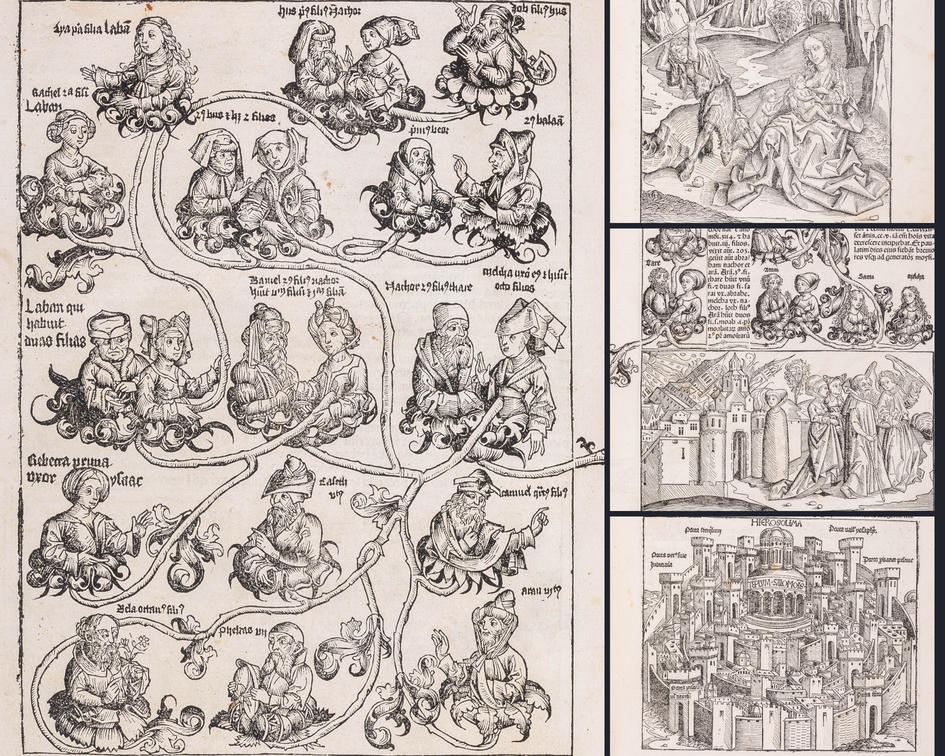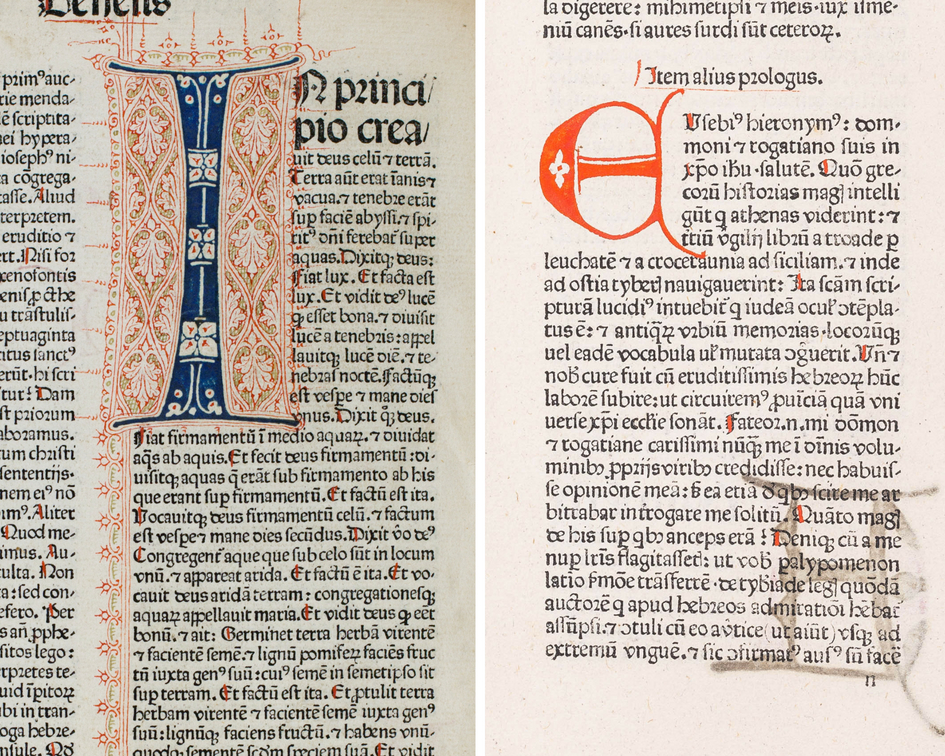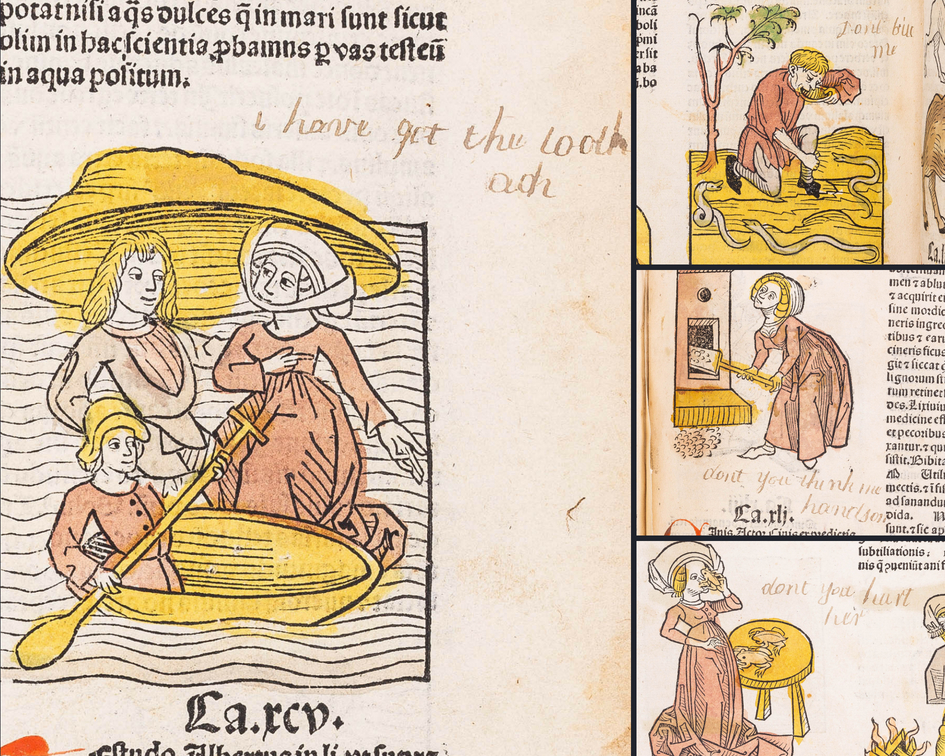Jessica Bigelow is a second-year English master’s student at Clark University and served as a Readers’ Services page this past summer. Her current master’s thesis focuses on medieval literature, and she aspires to someday be a rare book curator working with medieval and early modern materials. Her time at AAS fostered her passion for the curation and preservation of early published works.
As an English master’s student with a particular interest in medieval studies, I didn’t ever expect my interests to align with the materials housed at the American Antiquarian Society. After I began working here as a page, however, I discovered a little-known collection within the Society—a collection of medieval incunables. Now, the definition of an incunable, or incunabula (a word that literally translates to “from the cradle”), is a book that was printed during the first fifty years after the invention of the European printing press, roughly 1450 to 1500 CE. Therefore, it came as a shock to me that an institution focused on collecting materials printed in what is now the United States before 1877 would hold texts that were not only non-American but printed significantly earlier than the set timeline of the Society’s collection. Because of this, I decided to dig deeper into this collection of incunables and see what I could discover about their connection to the rest of the collections housed within AAS.
Doing so came with some difficulties, however. First, because these items are not the stated focus of the Society’s collection, they were not fully cataloged when I began this project. (This is also one of the reasons it is not well known that the Society owns these texts.) Of the six incunables that AAS currently holds, only three had online catalog records when I began this project, although all have since been cataloged. Furthermore, those records that did exist were limited and difficult to use. For example, one of the most interesting (in my opinion) incunables the Society owns is a copy of Liber Cronicarum, otherwise known as the Nuremberg Chronicle, printed in 1493. The Nuremberg Chronicle is a  history of the world that begins with biblical times and continues through the fifteenth century, touching on many major cities and political/religious figures from history. The Chronicle is also revered for its liberal use of woodcut illustrations (such as the images shown here), which depict the people and places being discussed throughout history. Not only is this text vastly interesting to study on its own, the AAS copy is particularly valuable because it is in excellent condition. The catalog record for this text, however, is almost entirely in Latin, which makes it hard to find in the online catalog and also hard to decipher if you do find it. Furthermore, although this record contains all the information needed to find the Nuremberg Chronicle, the information provided is very technical and not very user-friendly.
history of the world that begins with biblical times and continues through the fifteenth century, touching on many major cities and political/religious figures from history. The Chronicle is also revered for its liberal use of woodcut illustrations (such as the images shown here), which depict the people and places being discussed throughout history. Not only is this text vastly interesting to study on its own, the AAS copy is particularly valuable because it is in excellent condition. The catalog record for this text, however, is almost entirely in Latin, which makes it hard to find in the online catalog and also hard to decipher if you do find it. Furthermore, although this record contains all the information needed to find the Nuremberg Chronicle, the information provided is very technical and not very user-friendly.
Confusing catalog records for incunables are common, as they are notoriously hard to catalog due to missing leaves, lack of publication information, faded text, and other time-consuming difficulties. At AAS, because they are outside of the normal collection scope and because the Society does not have a curator specialized in materials from that time period, creating detailed catalog records is especially difficult. Fortunately, AAS currently has someone working very hard to improve these catalog records, which will make them much easier to find and access in the near future.
Once I was able to get into the text of the Nuremburg Chronicle, as well as a few of the other incunables, I discovered an interesting connection between the incunable collection and the rest of the material owned by the AAS, which helped me discover how they ended up here. Several of the incunables were donated by Isaiah Thomas, the Society’s founder, and he left extensive notes within each incunable on both the monetary value and the academic value of each piece based on their connection to the history of printing. This has led me to the conclusion that the incunables were kept not just for their donors’ connections to the Society—some other notable donors of incunables were the Mather and Hunnewell families, which you can read more about here and here—but because of their connection to the Society’s history. The Society had a much broader scope when originally founded by Thomas, and it was only in the 1970s that it was narrowed to North America. This new scope lessened the broad interest the Society used to have in the history of printing. There are a number of other resources at AAS that also deal with the history of early European printing, the existence of which makes the presence of the incunables within the collection make sense.

This change in scope led me to my second difficulty—deaccessioning. Deaccessioning is the official disposal of items within a library collection, which generally entails selling those items in order to raise money for the library. In the early 1970s, several of the Society’s dozen incunables were deaccessioned; there was a lot of change happening to the Society’s collection during the ’70s, and the deaccessioning of these incunables appear to go hand-in-hand with AAS lessening its focus on the general history of printing within the collection. I tried to discover where the texts went after being a part of our collection, but although the American Antiquarian Society Proceedings of 1873 and 1879 list these incunables as being owned by the Society, during the short time I was at AAS I was not able to find the records that indicate who bought them during their deaccessioning.
 Therefore, my research into the incunable collection at AAS led me down many mysterious rabbit holes that did not always lead to answers. But, one thing I definitively learned was how unique and interesting this collection of incunables is. To prove this, I’ll leave you with this final example of an incunable you can find at the Society: the Hortus Sanitatis, printed in 1491. The Hortus Sanitatis was the first natural history encyclopedia and was published by Jacob Meydenbach in Mainz, Germany, the home of the first European printing press. Many copies of this text still survive, and the Society’s copy, like many others, is in poor condition. Therefore, this copy is not considered special just because it survived. Rather, it is the annotations that make this text not only academically interesting, but fun to look at as well. As you can see from the images, the book is full of hand-painted woodcut illustrations of the different plants, animals, and people that are discussed throughout the encyclopedia. Many of these images have readers’ marks next to them that contain puns and jokes applying to the image they are situated next to, enhancing anyone’s reading of this delicate text. While the culprit of these notations is currently unknown, I hope to someday learn their name—and if you come and see this amazing collection, maybe you can figure it out for me!
Therefore, my research into the incunable collection at AAS led me down many mysterious rabbit holes that did not always lead to answers. But, one thing I definitively learned was how unique and interesting this collection of incunables is. To prove this, I’ll leave you with this final example of an incunable you can find at the Society: the Hortus Sanitatis, printed in 1491. The Hortus Sanitatis was the first natural history encyclopedia and was published by Jacob Meydenbach in Mainz, Germany, the home of the first European printing press. Many copies of this text still survive, and the Society’s copy, like many others, is in poor condition. Therefore, this copy is not considered special just because it survived. Rather, it is the annotations that make this text not only academically interesting, but fun to look at as well. As you can see from the images, the book is full of hand-painted woodcut illustrations of the different plants, animals, and people that are discussed throughout the encyclopedia. Many of these images have readers’ marks next to them that contain puns and jokes applying to the image they are situated next to, enhancing anyone’s reading of this delicate text. While the culprit of these notations is currently unknown, I hope to someday learn their name—and if you come and see this amazing collection, maybe you can figure it out for me!
Further Reading:
Bouchot, Henri. The Book: Its Printers, Illustrators, and Bonders, from Gutenberg to the Present Time. London: H. Grevel & Co., 1890.
Duff, E. Gordon. Early Printed Books. London: Trübner & Co., Ltd., 1893.
Haebler, Konrad. The Study of Incunabula. New York: Grolier Club, 1933.

Fascinating! As the curator of a small collection of Massachusetts history, it leaves me wondering about the parameters of deaccessioning. Should we keep sample items in our collections that fall outside our current collections policies if they are special and can be used as an example of what the collections policy USED to be? But described as such. And it also drives home the necessity for clear deaccessioning records — where an item went. Thank you Jessica and AAS.
Have you visited the following website at Oxford devoted to the 15th C. book trade? It is really special.
http://15cbooktrade.ox.ac.uk/
Elinor,
No, I have not visited that website, but it looks really interesting! Thank you for sharing, I will make sure to check it out.
Jessica